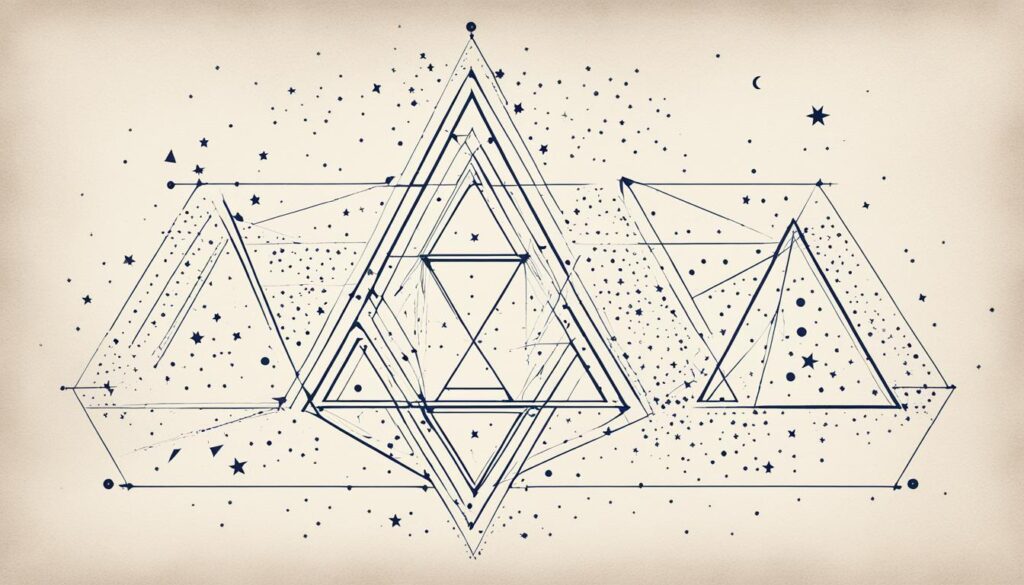| Genitive | |
| Abbreviation | |
| Pronunciation | |
| Main Stars | |
| Brightest Star | |
| Right Ascension | |
| Declination | |
| Sq. Deg. Area | |
| Crosses Meridian | |
| Visible Lat. Range |
Embark on a celestial journey to explore the Triangulum constellation, a captivating tapestry in the night sky known for its geometric elegance. Although not as flamboyant as its celestial neighbors, the constellation Triangulum offers a profound glimpse into the universe’s mystique. Occupying 132 square degrees in the first quadrant of the northern hemisphere (NQ1), you can spot this constellation nestled between latitudes +90° and -60°. Standing as the 78th largest constellation, Triangulum’s history dates back to the 2nd century, chronicled by the astute Greek astronomer Ptolemy.
Iconic for its narrow, elongated shape, the Triangulum star pattern is part of the great Perseus family. Yet, what it lacks in brightness, it compensates with the presence of the illustrious Triangulum Galaxy (Messier 33)—a celestial marvel visible to the naked eye. Triangulum, acknowledged as ‘Tri’ by the International Astronomical Union (IAU), stands proudly among the 88 modern constellations, beckoning stargazers to its understated beauty.
Key Takeaways
- The Triangulum constellation is a subtle yet fascinating feature of the northern sky.
- Known for its pointed, geometric pattern, it is part of the celebrated Perseus constellation family.
- Triangulum harbors the well-known Triangulum Galaxy, an observable deep-space wonder.
- Designated ‘Tri’ by the IAU, it’s included in the expansive catalogue of present-day constellations.
- Originally catalogued by Ptolemy, its legacy endures through its simplicity and historical significance.
- Despite a lack of first magnitude stars, Triangulum’s allure lies in its depth and the mysteries it houses.
Discovering the Constellation Triangulum: A Stargazer’s Primer
As you gaze upon the celestial tapestry, you’ll find the Triangulum classification as a constellation that invokes the beauty of geometric shapes within the cosmos. This stretched triangle of stars is not just a delightful arrangement for stargazers; it’s a slice of celestial history. Legend has it that the three main stars have represented everything from the fertility of the Nile Delta to the rugged terrains of Sicily.
Adjacent to the more vivid constellations of Andromeda and Perseus, Triangulum forms a serene constellation corner that might be modest in brightness, but rich in cosmic tales. Despite lacking the same flashiness as its neighboring Triangulum celestial objects, its presence is unmistakable once you know where to look. Let’s say you initiate your stellar journey from the Great Square of Pegasus; this will guide you toward the Andromeda Galaxy. Along this celestial path, you’ll encounter the pattern of Triangulum—a geometric guide to the night sky’s wonders.
In the realm of the zodiac, Triangulum holds no place, but in the nightscape, it is a symbol. Not recognized as an Triangulum astrological sign, it nonetheless sparks a connection for those who seek patterns in the vast universe. Whether you’re a novice to the field of astronomy or seasoned with a telescope at hand, beholding the Triangulum constellation becomes a moment of astronomical joy and contemplation.
- Begin at the Great Square of Pegasus to find your way.
- Seek the Andromeda Galaxy as a landmark.
- Trace the stretched triangular shape distinguishing Triangulum.
- Embrace the constellation’s modest glow and renowned history.
Remember, while the constellations you find may not control your destiny like an astrological sign, they bring the stories of our ancestors and the science of the stars together in a harmonious symphony for us to discover. So peer into the heavens, and let Triangulum be your celestial compass.
Historical Significance of the Triangulum Star Pattern
The constellation Triangulum holds a mesmerizing place in both the night sky and the annals of ancient history. Steeped in mythology and eons of astral observation, this celestial landmark bridges past civilizations with the cosmos. Through its simple shape, Triangulum offers a rich tapestry of narratives that continue to intrigue stargazers and historians alike.
Origin in Ancient Civilizations
Triangulum’s history is as vast as the universe it occupies. Known to the Greeks as Deltoton, the constellation bore semblance to the uppercase version of their fourth letter. This connection to language and learning underscores the significance ancient societies placed on celestial patterns.
Relevance in Greek Mythology
In the realm of ancient Greek constellations, Triangulum is less prominent in traditional mythology but its geometric elegance was nonetheless celebrated. As part of the 48 constellations listed by the astronomer Ptolemy, its presence persists today as a testament to its enduring appeal.
The Tale of Sicily’s Celestial Tribute
The stars of Triangulum have also been connected to the soil of Sicily. In homage to the island’s patron goddess Ceres, the constellation still reflects the rich cultural and agricultural heritage she was believed to foster. This unique intersection of Triangulum mythology with terrestrial lore beautifully illustrates how the stars have shaped, and were shaped by, human culture.

| Civilization | Name for Triangulum | Mythological Significance |
|---|---|---|
| Ancient Greeks | Deltoton | Resembling the Greek letter Δ (Delta) |
| Ancient Babylonians | Plough | Associated with farming and fertility |
| Romans | Sicilia | Linked to the goddess Ceres and the island of Sicily |
The Cosmic Trio: Key Stars of Triangulum
Discover the glittering apexes that frame the Triangulum constellation. These stellar beacons, known as the Triangulum Brightest Stars—Beta Trianguli, Alpha Trianguli, and Gamma Trianguli—are not just points of light but are dynamic celestial bodies that reveal the complexities of the universe right from our earthly vantage point.

Beta Trianguli, the constellation’s luminary, is a spectroscopic binary system that twinkles with an apparent magnitude of 3.00. At a distance of roughly 127 light years from Earth, this white giant’s binary components are a testament to the gravitational bonds that govern cosmic choreography. Following closely in brilliance is Alpha Trianguli, affectionately referred to as Mothallah. This binary star system, situated 63.3 light years away, boasts a rapid rotational speed, which contributes to its distinctive ellipsoidal form.
Completing the trio is Gamma Trianguli, recognized by its A-type stellar classification. Its presence contributes to the distinct geometric profile of the constellation. Each member of this cosmic triptych not only illuminates the night sky but also characterizes a unique facet of stellar evolution and interactions. From tracing infrared signatures of surrounding debris discs to observing the influence of rotational velocities on luminosity, each star is a celestial case study unto itself.
| Star Name | Apparent Magnitude | Distance (Light Years) | Classification | Notable Characteristics |
|---|---|---|---|---|
| Beta Trianguli | 3.00 | ~127 | Spectroscopic Binary System | White giant with gravitational binding |
| Alpha Trianguli (Mothallah) | 3.41 | ~63.3 | Binary System | Ellipsoidal shape due to rapid rotation |
| Gamma Trianguli | 4.00 | — | A-type Star | Part of geometric constellation profile |
Whether you are a seasoned astronomer or a casual stargazer, observing these stellar giants offers a profound appreciation for the vastness and beauty of our galaxy. Your journey through the cosmos begins with the outlining of a simple triangle in the sky, cradling the secrets of the universe within its spectral vertices.
Navigating the Night Sky: How to Locate the Triangulum Constellation
If you’re a stargazing aficionado or simply enjoy the occasional upward glance at the night sky, locating the Triangulum constellation is a rewarding pursuit. Nestled among the night sky’s vast expanse, Triangulum is easier to find than one might think, given the right approach and understanding of celestial coordinates. Noted for its visibility primarily from the northern hemisphere, the constellation is a cosmic showcase, most visible in December.
Identifying Triangulum Among Neighboring Constellations
Your celestial journey to finding Triangulum begins by charting a path through its neighboring constellations. Andromeda, Aries, Perseus, and Pisces — each of these provides a celestial signpost to your destination. By understanding the pattern of these neighboring groups, you can discern the location of Triangulum’s elongated triangular shape. This method of Triangulum celestial navigation ensures you appreciate the constellation’s position in relation to the surrounding constellational context.
Using Seasonal Skies to Your Advantage
Celestial explorers should take advantage of the seasonal skies to enhance their observation experience. With its coordinates close to the celestial equator, Triangulum is optimally situated in the sky’s dome during winter, especially for those viewing from between +90 and -60 degrees latitude. In this vast celestial theatre, Triangulum visibility peaks, presenting an ideal time to gaze upon this constellation’s grandeur. Mark these coordinates, embrace the chill of winter’s nocturne, and allow the constellation to reveal itself within its celestial quadrant. There, you’ll find not just the geometric allure of Triangulum’s stars, but the gateway to observing other deep-sky wonders it harbors.
FAQ
What is the Triangulum constellation?
The Triangulum constellation is a small constellation in the northern sky that resembles a long, narrow triangle. It is part of the Perseus family of constellations and is notable for containing the Triangulum Galaxy (Messier 33), which is visible to the naked eye under dark skies.
Where is the Triangulum constellation located in the sky?
Triangulum is located in the first quadrant of the northern hemisphere (NQ1) and can be seen at latitudes between +90° and -60°. The constellation is nestled between the constellations of Andromeda to the west, Pisces to the south, and Aries to the east.
When is the best time to view the Triangulum constellation?
The best time to view the Triangulum constellation is during the month of December, when it is most prominently visible in the night sky, particularly from northern latitudes.
How can I identify the Triangulum celestial body?
To identify the Triangulum celestial body, look for its three defining stars, Beta, Alpha, and Gamma Trianguli, which form a stretched triangular shape. It can often be located by starting from the Great Square of Pegasus or by using the Andromeda Galaxy as a reference point.
Why is the constellation Triangulum historically significant?
Triangulum is historically significant due to its longstanding recognition by many ancient civilizations, including the Greeks and Babylonians. It is believed to have symbolized various geographical and mythological elements such as the delta of the Nile River, the island of Sicily, or the plough, reflecting its deep-rooted cultural significance.
What are the brightest stars in the Triangulum constellation?
The brightest stars in the Triangulum constellation are Beta Trianguli, a binary white giant star with an apparent magnitude of 3.00, Alpha Trianguli, also known as Mothallah, which is a binary star system, and Gamma Trianguli, an A-type star. Together, these stars form the iconic triangular pattern of the constellation.
Can you tell me more about the Triangulum Galaxy?
The Triangulum Galaxy, also known as Messier 33, is a member of the Local Group of galaxies, which includes the Milky Way. It is the third-largest galaxy in the group and one of the most distant objects that can be viewed with the naked eye. The galaxy is located within the boundaries of the Triangulum constellation and is noted for its spiral arms and a plethora of star-forming regions.
Is there an astrological sign associated with Triangulum?
No, Triangulum is not associated with any astrological sign. Astrological signs correspond to the 12 zodiac constellations, which Triangulum is not a part of.
How do I use celestial navigation to find Triangulum?
To use celestial navigation to find Triangulum, familiarize yourself with its position in relation to the ecliptic and the celestial equator. Using seasonal skies and the locations of neighboring constellations such as Andromeda and Aries can also help in pinpointing its location.
What is the celestial classification of Triangulum?
Celestially, Triangulum is classified as a constellation in the northern hemisphere, specifically categorized by the International Astronomical Union with the abbreviation ‘Tri’. It is one of the 88 modern constellations recognized in contemporary astronomy.
Are there any other notable celestial objects in the Triangulum constellation?
In addition to the Triangulum Galaxy, the constellation also hosts several other celestial objects, including the Pinwheel Galaxy (NGC 598), numerous open clusters, and some interesting variable stars. While these objects may not be as well-known or as easily visible to the naked eye as Messier 33, they are fascinating subjects for observation through telescopes or other astronomical equipment.






